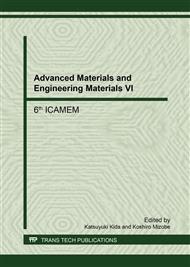[1]
Fujishma A, Honda K, Electrochemical photolysis of water at a semiconductor electrode. Nature, 37(1972) 238-243.
Google Scholar
[2]
Han Shitong, Xi Hailing, Shi Ruixue, Fu Xianzhi, Wang Xuxu, Prospect and progress in the semiconductor photocatalysis. Chinese J Chem Phys, 16(2003)339-349.
Google Scholar
[3]
Kudo A, Hijii S, H2 or O2 evolution from aqueous solutions on layered oxide photocatalysis consisting of Bi3+ with 6s2 configuration and d0 transition metal ions, Chem Lett, 28(1999) 1103-1104.
DOI: 10.1246/cl.1999.1103
Google Scholar
[4]
Yang Yingjie, Chen Jianlin, Wang Yichun, Yao Sanli, Xu Ti, Li Di, Synthesis and characterization of catalyst Bi2WO6 and its photocatalytic activity. Environmental Protection of Chemical Industry, 27(2007) 501-505.
Google Scholar
[5]
Shu Kaizheng, Tang Jie, Jiang Xianping, Zhan Hongquan, Research on hydrothermal synthesis and photocatalytic activity of super Bi2WO6 microspheres. China Ceramics, 48(2012) 14-16.
Google Scholar
[6]
Zhu Zhenfeng, Yu Hongguang, Li Junqi, Du Juan, Wang Defang, One step template-free synthesis of nest like Bi2WO6 microspheres and enhanced photocatalytic activity. Journal of Functional Materials, 4(2012) 409-416.
Google Scholar
[7]
Xing Guangjian, Li Yu Mei, Zhao Zheng, Wang Yi, Wu Guangming, Preparation and photocatalytic properties of bismuth tungsten oxide nanomaterials with different morphologies. Journal of Synthetic Crystals, 39(2010) 1265-1271.
Google Scholar
[8]
Zhang Lisha, Wang Huanli, Li Shijie, Liu Jianshe, Research progress in Bi2WO6 based nano- photocatalysts. Modern Chemical Industry, 32(2012) 36-39.
Google Scholar
[9]
Liu Zili, Qin Zuzeng, Wei Jianghui, Effect of calcined temperature on the Bi2WO6 photocatalyst Journal of Guangxi University (Nat Sci Ed), 31(2006)82-85.
Google Scholar
[10]
Shang M, Wang W, Zhang L, Bi2WO6 with significantly enhanced photocatalytic activities by nitrogen doping. Mater Chem Phys, 120(2010)155-159.
DOI: 10.1016/j.matchemphys.2009.10.039
Google Scholar
[11]
Shi R, Huang G, Lin J, Photocatalytic activity enhancement for Bi2WO6 by fluorine substitution. J Phys Chem C, 113(2009) 19633-19638.
DOI: 10.1021/jp906680e
Google Scholar
[12]
Zhang Z, Wang W, Yin W, Inducing photocatalysis by visible light beyond the absorption edge: Effect of upconversion agent on the photocatalytic activity of Bi2WO6. Appl Catal B: Environ., 101(2010) 68-73.
DOI: 10.1016/j.apcatb.2010.09.008
Google Scholar
[13]
Xiao Q, Zhang J, Xiao C, Tan X K, Photocatalytic degradation of methylene blue over Co3O4/ Bi2WO6 composite under visible light irradiation. Catal Commun, 9(2008)1247-1253.
DOI: 10.1016/j.catcom.2007.11.011
Google Scholar
[14]
Xu J, Wang W, Sun S, Enhancing visible-light-induced photocatalytic activity by coupling with wide-band-gap semiconductor: A case study on Bi2WO6/TiO2. Appl Catal B: Environ., 111(2012)126-132.
DOI: 10.1016/j.apcatb.2011.09.025
Google Scholar
[15]
Ying Hong, Wang Zhiyong, Guo Zhengduo, Shi Zujin, Yang Shangfeng, Reduced graphene oxide-modified Bi2WO6 as an improved photocatalyst under visible light. Acta Phys. -Chim. Sin. 27(2011)1482-1486.
Google Scholar
[16]
Zhao Hongli, Progress of preparation of Bi2WO6 for visible-light photocatalyst. Journal of Tangshan Teachers College, 34(2014)11-15.
Google Scholar


